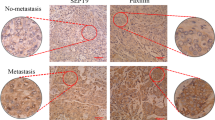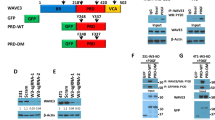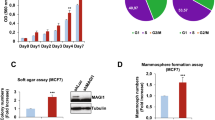Abstract
Transformation of mammary epithelial cells into invasive carcinoma results in alterations in their integrin-mediated responses to the extracellular matrix, including a loss of normal epithelial polarization and differentiation, and a switch to a more motile, invasive phenotype. Changes in the actin cytoskeleton associated with this switch suggest that the small GTPases Cdc42 and Rac, which regulate actin organization1,2, might modulate motility and invasion. However, the role of Cdc42 and Rac1 in epithelial cells, especially with respect to integrin-mediated events, has not been well characterized. Here we show that activation of Cdc42 and Rac1 disrupts the normal polarization of mammary epithelial cells in a collagenous matrix, and promotes motility and invasion. This motility does not require the activation of PAK, JNK, p70 S6 kinase, or Rho, but instead requires phosphatidylinositol-3-OH kinase (PI(3)K). Further, direct PI(3)K activation is sufficient to disrupt epithelial polarization and induce cell motility and invasion. PI(3)K inhibition also disrupts actin structures, suggesting that activation of PI(3)K by Cdc42 and Rac1 alters actin organization, leading to increased motility and invasiveness.
This is a preview of subscription content, access via your institution
Access options
Subscribe to this journal
Receive 51 print issues and online access
$199.00 per year
only $3.90 per issue
Buy this article
- Purchase on Springer Link
- Instant access to full article PDF
Prices may be subject to local taxes which are calculated during checkout





Similar content being viewed by others
References
Ridley, A. J., Paterson, H. F., Johnston, C. L., Diekmann, D. & Hall, A. The small GTP-binding protein rac regulates growth factor-induced membrane ruffling. Cell 70, 401–410 (1992).
Nobes, C. D. & Hall, A. Rho, Rac, and Cdc42 GTPases regulate the assembly of multimolecular focal complexes associated with actin stress fibers, lamellipodia, and filopodia. Cell 81, 53–62 (1995).
Keely, P., Fong, A., Zutter, M. & Santoro, S. Alteration of collagen-dependent adhesion, motility, and morphogenesis by the expression of antisense α2 integrin mRNA in mammary cells. J. Cell Sci. 108, 595–607 (1995).
Whitehead, I. P., Campbell, S., Rossman, K. L. & Der, C. J. Dbl family proteins. Biochim. Biophys. Acta 1332, F1–F23 (1997).
Glaven, J. A., Whitehead, I. P., Nomanbhoy, T., Kay, R. & Cerione, R. A. Lfc and Lsc oncoproteins represent two new guanine nucleotide exchange factors for the Rho GTP-binding protein. J. Biol. Chem. 271, 27374–27381 (1996).
Adams, A. E. M., Johnson, D. I., Longnecker, R. M., Sloat, B. F. & Pringle, J. R. Cdc42 and Cdc43, two additional genes involved in budding and the establishment of cell polarity in the yeast Saccharomyces cerevisiae. J. Cell Biol. 111, 131–142 (1990).
Eaton, S., Auvinen, P., Luo, L., Jan, Y. N. & Simons, K. Cdc42 and Rac1 control different actin-dependent processes in the Drosophila wing disc epithelium. J. Cell Biol. 131, 151–164 (1995).
Stowers, L., Yelon, D., Berg, L. J. & Chant, J. Regulation of the polarization of T cells toward antigen-presenting cells by Ras-related GTPase CDC42. Proc. Natl Acad. Sci. USA 92, 5027–5031 (1995).
Michiels, F., Habets, G. G. M., Stam, J. C., van der Kammen, R. & Collard, J. G. Arole for Rac in Tiam1-induced membrane ruffling and invasion. Nature 375, 338–340 (1995).
van Leeuwen, F. N., van der Kammen, R. A., Habets, G. G. & Collard, J. G. Oncogenic activity of Tiam-1 and Rac1 in NIH3T3 cells. Oncogene 11, 2215–2221 (1995).
Collard, J. G. Signaling pathways regulated by Rho-like proteins: A possible role in tumor formation and metastasis. Int. J. Oncol. 8, 131 (1996).
Teramoto, H. et al. Signaling from the small GTP-binding proteins Rac1 and Cdc42 to the c-Jun N-terminal Kinase/Stress-activated protein kinase pathway. J. Biol. Chem. 271, 27225–27228 (1996).
Minden, A., Lin, A., Claret, F. X., Abo, A. & Karin, M. Selective activation of the JNK signaling cascade and c-jun transcriptional activity by the small GTPases Rac and Cdc42Hs. Cell 81, 1147–1157 (1995).
Coso, O. A. et al. The small GTP-binding proteins Rac1 and Cdc42 regulate the activity of the JNK/SAPK signaling pathway. Cell 81, 1137–1146 (1995).
Joneson, T., McDonough, M., Bar-Sagi, D. & Van Aelst, L. Rac regulation of actin polymerization and proliferation by a pathway distinct from Jun kinase. Science 274, 1374–1376 (1996).
Westwick, J. K. et al. Rac regulation of transformation, gene expression, and actin organization by multiple, PAK-independent pathways. Mol. Cell Biol. 17, 1324–1335 (1997).
Yan, M. et al. Activation of stress-activated protein kinase by MEKK1 phosphorylation of its activator SEK1. Nature 372, 798–800 (1994).
Lamarche, N. et al. Rac and Cdc42 induce actin polymerization and G1 cell cycle progression independently of p65PAK and the JNK/SAPK MAP kinase cascade. Cell 87, 519–529 (1996).
Chou, M. M. & Blenis, J. The 70 kDa S6 kinase complexes with and is activated by the Rho family G proteins Cdc42 and Rac1. Cell 85, 573–583 (1996).
Blenis, J., Chung, J., Erikson, E., Alcorta, D. A. & Erikson, R. L. Distinct mechanisms for the activation of the RSK kinases/MAP2 kinase/pp90rsk and pp70 S6 kinase signaling systems are indicated by inhibition of protein synthesis. Cell Growth Differ 2, 279–285 (1991).
Peppelenbosch, M. P. et al. Rac mediates growth factor-induced arachidonic acid release. Cell 81, 849–856 (1995).
Zheng, Y., Bagrodia, S. & Cerione, R. A. Activation of phosphoinositide 3-kinase activity by Cdc42Hs binding to p85. J. Biol. Chem. 269, 18727–18730 (1994).
Tolias, K. F., Cantley, L. C. & Carpenter, C. L. Rho family GTPases bind to phosphoinositide kinases. J. Biol. Chem. 270, 17656–17659 (1995).
Rodriguez-Viciana, P., Warne, P. H., Vanhasebroeck, B., Waterfield, M. D. & Downward, J. Activation of phosphoinositide 3-kinase by interaction with Ras and by point mutation. EMBO J. 15, 2442–2451 (1996).
Rodriguez-Viciana, P. et al. Role of phosphoinositide 3-OH kinase in cell transformation and control of the actin cytoskeleton by Ras. Cell 89, 457–467 (1997).
Whitehead, I., Kirk, H., Tognon, C., Trigo-Gonzalez, G. & Kay, R. Expression cloning of lfc, a novel oncogene with structural similarities to guanine nucleotide exchange factors and to the regulatory region of protein kinase C. J. Biol. Chem. 270, 18388–18395 (1995).
Whitehead, I. P. et al. Expression cloning of lsc, a novel oncogene with structural similarities to the Dbl family of guanine nucleotide exchange factors. J. Biol. Chem. 271, 18643–18650 (1996).
Santoro, S. A. et al. Analysis of collagen receptors. Methods Enzymol. 245, 147–183 (1994).
Auger, K. R., Serunian, L. A., Soltoff, S. P., Libby, P. & Cantley, L. C. PDGF-dependent tyrosine phosphorylation stimulates production of novel polyphosphoinositides in intact cells. Cell 57, 167–175 (1989).
Acknowledgements
We thank L. Van Aelst for the Rac1(12V) effector-domain plasmids and discussion; J. Downward for the p110(K227E) construct; J. Kwong and J. McCarthy for discussion; L. Graves for assistance with PI(3)K and S6 kinase assays; C. Bradham for assistance with JNK assays and Q. Lambert for technical assistance. This work was supported by grants from the Elsa Pardee Foundation and NIH.
Author information
Authors and Affiliations
Corresponding author
Rights and permissions
About this article
Cite this article
Keely, P., Westwick, J., Whitehead, I. et al. Cdc42 and Rac1 induce integrin-mediated cell motility and invasiveness through PI(3)K. Nature 390, 632–636 (1997). https://doi.org/10.1038/37656
Received:
Accepted:
Published:
Issue Date:
DOI: https://doi.org/10.1038/37656
This article is cited by
-
Rac1 deficiency impairs postnatal development of the renal papilla
Scientific Reports (2022)
-
Metabolic enzyme LDHA activates Rac1 GTPase as a noncanonical mechanism to promote cancer
Nature Metabolism (2022)
-
A novel HDGF-ALCAM axis promotes the metastasis of Ewing sarcoma via regulating the GTPases signaling pathway
Oncogene (2021)
-
Rho-GTPase pathways may differentiate treatment response to TNF-alpha and IL-17A inhibitors in psoriatic arthritis
Scientific Reports (2020)
-
Encircling the regions of the pharmacogenomic landscape that determine drug response
Genome Medicine (2019)
Comments
By submitting a comment you agree to abide by our Terms and Community Guidelines. If you find something abusive or that does not comply with our terms or guidelines please flag it as inappropriate.



